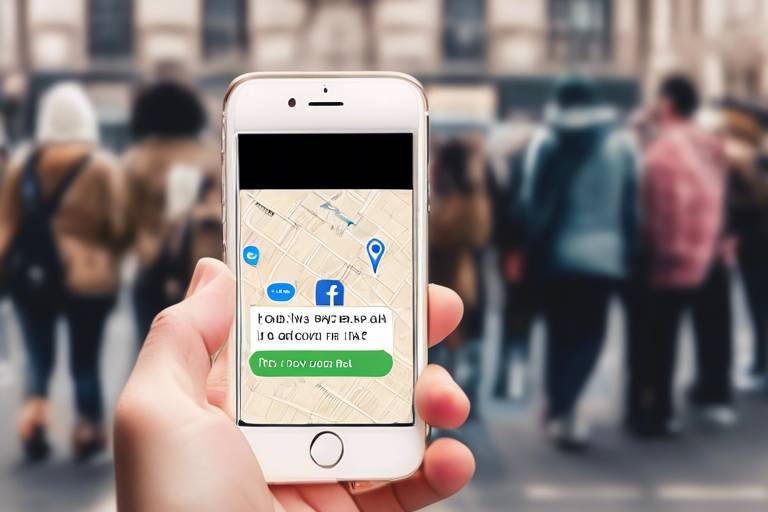Guiding Your Kids Towards Safe Social Media Practices
In today's digital age, navigating the vast world of social media can feel like sailing through uncharted waters for both parents and children. With the click of a button, your child can connect with friends, share their thoughts, and express themselves creatively. However, this exciting journey is not without its challenges. As a parent, it's essential to equip your kids with the right tools and knowledge to make their social media experience not only enjoyable but also safe. So, how can you guide your children through this complex landscape? Let's dive into some practical strategies that will empower them to navigate social media responsibly.
First and foremost, it’s crucial for parents to grasp the potential dangers lurking in the shadows of social media. Think of it as a bustling city filled with both friendly faces and hidden threats. Children may encounter cyberbullying, where hurtful comments and harassment can follow them online. There are also significant privacy concerns; what seems harmless today could lead to unwanted attention tomorrow. Additionally, exposure to inappropriate content can happen in the blink of an eye. By understanding these risks, you can better prepare your kids to face them head-on.
One of the most effective ways to protect your children is by establishing clear boundaries regarding social media use. Imagine setting the rules for a game; without them, chaos ensues. By defining specific guidelines, you help your children understand what is acceptable behavior online. This not only fosters responsible engagement but also encourages them to communicate openly about their experiences. Regularly discussing their online interactions can create a safe space where they feel comfortable sharing any concerns or issues they encounter.
Different social media platforms cater to various age groups, much like how certain TV shows are rated for specific audiences. As a parent, it’s essential to be aware of which platforms are suitable for your children. For instance, platforms like Instagram and Snapchat may not be ideal for younger kids, while others like Kidzworld and GooseChase provide a safer environment for them to interact. Understanding these distinctions can help you make informed decisions about where your children should engage online.
When exploring social media options for younger users, consider platforms designed specifically for kids. Here’s a quick look at some popular choices:
| Platform | Age Group | Features |
|---|---|---|
| Kidzworld | 8-16 years | Chat rooms, games, and forums |
| GooseChase | All ages | Interactive scavenger hunts |
| Club Penguin | 6-14 years | Virtual world with games and chat |
Keeping track of your child's social media usage is essential for maintaining their safety. Just like a coach keeps an eye on players during a game, you should monitor the time and content your children consume online. This not only helps ensure they develop healthy online habits but also allows you to step in if you notice any concerning behavior or interactions. Regular check-ins can make a world of difference in safeguarding their online experience.
Creating a trusting environment where your children feel comfortable discussing their online experiences is crucial. Think of it as building a bridge of communication that allows them to cross safely over the turbulent waters of social media. When kids know they can come to you with questions or concerns, they are more likely to seek help when they encounter issues, whether it's a mean comment or an uncomfortable interaction. Regularly engaging in conversations about their online lives can strengthen this bond.
In a world where sharing personal information is as easy as pie, teaching your children about privacy awareness is vital. They need to understand the importance of privacy settings and the implications of sharing personal information online. Imagine their digital footprint as a trail of breadcrumbs; once it's out there, it can be challenging to erase. By educating them on how to protect their information, you empower them to take control of their online presence.
Helping your children navigate privacy settings on social media platforms is an essential step in ensuring they control who can view their content and interact with them. Encourage them to customize their settings to limit exposure to strangers and to review their friend lists regularly. A little bit of knowledge can go a long way in protecting their privacy.
Teaching kids to identify suspicious behavior or content online is like giving them a map to navigate through a maze. They should know what to look for, such as overly aggressive messages or requests for personal information. By recognizing these red flags, they can respond appropriately and seek help when necessary. Role-playing different scenarios can be a fun and effective way to prepare them for real-life situations.
Q: How can I start a conversation with my child about social media?
A: Begin by asking them about their favorite platforms and what they enjoy doing online. Share your own experiences and express your interest in understanding their world.
Q: What should I do if I discover my child is being bullied online?
A: Approach the situation calmly. Encourage them to talk about it, document the incidents, and report the behavior to the platform. Offer your support and guidance throughout the process.
Q: How can I monitor my child's social media without invading their privacy?
A: Establish an open dialogue about social media use. Set agreements on what you will monitor together, emphasizing that your goal is to ensure their safety.

Understanding Social Media Risks
In today’s digital age, social media has become an integral part of our daily lives, especially for children and teenagers. As parents, it’s essential to understand the myriad of risks associated with social media use. While platforms like Instagram, TikTok, and Snapchat can foster creativity and connection, they also expose kids to potential dangers that can affect their mental and emotional well-being. One of the most alarming risks is cyberbullying, which can take many forms, from hurtful messages to public shaming. This type of harassment can leave deep emotional scars, making it critical for parents to recognize the signs and intervene when necessary.
Another significant concern is privacy. Many children do not fully grasp the implications of sharing personal information online. They might think it's harmless to post their location, school name, or even photos of themselves, but these seemingly innocent actions can lead to unwanted attention or even dangerous situations. It's crucial for parents to educate their children about the importance of keeping personal information private and understanding the concept of a digital footprint.
Moreover, exposure to inappropriate content is another risk that cannot be overlooked. With just a few clicks, children can stumble upon violent, explicit, or otherwise unsuitable material. This exposure can be detrimental to their development and can influence their thoughts and behaviors in negative ways. As a parent, it’s vital to have ongoing conversations about what constitutes inappropriate content and how to handle it if they encounter it.
To better understand these risks, here’s a quick overview of some common social media dangers:
| Risk | Description |
|---|---|
| Cyberbullying | Harassment or bullying that occurs through digital platforms, often resulting in emotional distress. |
| Privacy Issues | The potential for personal information to be shared without consent, leading to safety concerns. |
| Inappropriate Content | Exposure to material that is not suitable for children, which can impact their mindset and behavior. |
Understanding these risks is the first step in protecting our children. By fostering an environment where they feel comfortable discussing their online experiences, parents can help their kids navigate the complexities of social media more safely. It’s not just about monitoring their activity; it’s about educating them to be responsible digital citizens. By doing so, we empower our children to make informed decisions and recognize the potential dangers lurking behind the screens.

Setting Clear Boundaries
In today's digital age, where social media has become an integral part of our lives, for children is more important than ever. As parents, it’s our duty to guide our kids through the vast and often chaotic world of social media. But how do we do that effectively? Establishing specific guidelines regarding social media use can serve as a compass, helping children navigate their online interactions while understanding what is acceptable behavior. Think of it as giving them a map to avoid potential pitfalls.
First and foremost, it’s essential to have an open dialogue with your children about their online activities. This means not just telling them what they can’t do but also explaining the why behind the rules. For instance, you might say, “We don’t share personal information online because it can lead to unwanted attention.” This approach not only fosters understanding but also encourages children to engage in conversations about their experiences. Remember, kids are naturally curious and will likely encounter various situations online that may confuse or concern them.
Moreover, you can create a social media contract with your children. This contract can outline the rules of engagement, such as:
- Time limits for daily use
- Types of content they can post or share
- Who they can interact with online
- Consequences for breaking the rules
By involving your children in this process, you empower them to take responsibility for their online presence. It’s a collaborative effort that can lead to a more respectful understanding of social media.
Another aspect of setting boundaries is to encourage regular check-ins about their social media experiences. Ask them questions like, “What do you enjoy most about your favorite platform?” or “Have you seen anything online that made you uncomfortable?” These conversations can help you gauge their comfort level and identify any potential issues before they escalate. It’s like having a safety net—one that can catch them before they fall into the deep end.
Lastly, it’s crucial to lead by example. Children often mimic the behavior of their parents, so demonstrating responsible social media use yourself can reinforce the boundaries you’ve set. Show them how you manage your online presence, respect others, and maintain privacy. This modeling behavior can be incredibly impactful, as it teaches them that social media can be a positive space when used wisely.
In summary, setting clear boundaries around social media use is essential for helping children develop healthy online habits. By fostering open communication, creating a social media contract, encouraging regular check-ins, and leading by example, you can guide your children towards a safer and more positive online experience.

Age-Appropriate Platforms
When it comes to social media, not all platforms are created equal, especially for kids. Just like you wouldn't send a toddler to a high school party, you shouldn't let your child roam freely on platforms designed for older users. Understanding age-appropriate platforms is essential for ensuring that your child has a safe and positive online experience. Many social media networks cater specifically to children and teenagers, offering a more controlled environment that minimizes exposure to inappropriate content and risky interactions.
For instance, platforms like Kidzworld and Grom Social are designed with younger audiences in mind. They provide a space where kids can connect with peers while enjoying content that is suitable for their age group. These platforms often have strict moderation policies and features that promote safe interactions, which can be a relief for parents. On the other hand, platforms like Facebook and Instagram are more suited for older teens due to their wide-ranging content and less stringent privacy controls.
To help you navigate these options, here's a quick comparison of popular age-appropriate platforms:
| Platform | Age Group | Features |
|---|---|---|
| Kidzworld | 8-16 years | Safe chat, games, and forums |
| Grom Social | 8-16 years | Safe social networking, video sharing |
| Snapchat | 13+ years | Photo sharing, stories, and messaging |
| 13+ years | Photo and video sharing, messaging |
As a parent, it's also important to engage in conversations with your kids about why certain platforms may not be suitable for them. Ask them questions like, "What do you like about this app?" or "Have you seen anything that made you uncomfortable?" This dialogue not only helps you gauge their understanding but also builds their critical thinking skills regarding online content.
Ultimately, the goal is to empower your children to make informed choices about their online presence. By guiding them towards age-appropriate platforms, you can help them enjoy the benefits of social media while keeping them safe from its pitfalls.

Popular Platforms for Kids
When it comes to social media, not all platforms are created equal, especially for our younger generation. As parents, it’s essential to choose platforms that prioritize safety and are designed with kids in mind. Some platforms are specifically tailored for younger audiences, providing a controlled environment where kids can interact without the overwhelming risks often associated with broader social media sites. Here are some popular platforms that cater to children:
| Platform | Age Group | Key Features |
|---|---|---|
| Kidzworld | 8-16 years |
|
| Club Penguin Rewritten | 6-14 years |
|
| GoNoodle | 5-12 years |
|
| Messenger Kids | 6-12 years |
|
These platforms not only entertain but also educate children on how to interact responsibly online. For instance, Kidzworld provides a safe chat environment where kids can connect with peers while being monitored by adults. Similarly, Messenger Kids offers a secure way for children to communicate with friends and family, ensuring parents have control over the interactions. By choosing these platforms, you can help your children build a positive online presence while minimizing exposure to harmful content.
Moreover, it’s important to have ongoing conversations with your kids about their online experiences. Ask them what they enjoy about these platforms, who they’re interacting with, and if they ever feel uncomfortable. This dialogue not only reinforces their safety but also strengthens your relationship, making them feel valued and understood. Remember, the goal is to guide them towards a safe and enjoyable online experience, where they can express themselves and connect with others in a healthy way.
Q1: What age is appropriate for children to start using social media?
A1: While it varies by platform, many experts suggest that children should be at least 13 years old to start using mainstream social media. However, platforms like Kidzworld and Messenger Kids are designed for younger users and can be introduced earlier with parental guidance.
Q2: How can I monitor my child's social media activity?
A2: You can monitor your child's activity by regularly checking their profiles, discussing their interactions, and using parental control tools that many platforms offer. It’s essential to maintain an open dialogue about their online experiences.
Q3: What should I do if my child encounters cyberbullying?
A3: If your child experiences cyberbullying, encourage them to talk to you immediately. Help them document the incidents and report the behavior to the platform. It's vital to reassure them that they’re not alone and that it’s not their fault.
Q4: Are there any apps that can help manage screen time?
A4: Yes, there are several apps available, such as Qustodio, Norton Family, and Screen Time, which allow you to set limits on usage, monitor activity, and ensure a balanced approach to screen time.

Monitoring Usage
In today's digital age, monitoring your child's social media usage is not just a good idea—it's essential. As parents, we want to foster independence, but we also need to keep a watchful eye on our kids' online activities. Think of it as a balancing act between giving them the freedom to explore and ensuring their safety in a vast, unpredictable online world. Regularly checking in on their social media habits can help you spot potential issues before they escalate.
One effective strategy is to set up a shared device policy. This means that all social media interactions happen on family-shared devices rather than personal ones. By doing this, you're not invading their privacy but rather creating an environment where they feel comfortable sharing their online experiences with you. Encourage them to show you their profiles, the friends they interact with, and the content they enjoy. This open dialogue can help demystify their online world.
It's also important to establish time limits on social media usage. Excessive screen time can lead to negative effects on mental health, including anxiety and depression. You might consider using apps that track usage, providing you with insights into how much time your child spends online. This data can be invaluable in discussions about healthy habits. For instance, you could create a simple table to track their usage over a week:
| Day | Time Spent on Social Media (Hours) |
|---|---|
| Monday | 2 |
| Tuesday | 1.5 |
| Wednesday | 3 |
| Thursday | 2.5 |
| Friday | 4 |
| Saturday | 5 |
| Sunday | 3 |
This table can serve as a springboard for conversations about balance and moderation. Ask your child how they feel about their social media time. Are they enjoying it, or do they feel pressured to be online constantly? This kind of inquiry not only shows that you care but also helps them reflect on their own habits.
Finally, consider using parental control tools that allow you to monitor your child's activities without being overbearing. These tools can alert you to inappropriate content or interactions, allowing you to step in when necessary. However, it's essential to communicate with your child about these measures. Explain that you're doing this out of love and concern for their safety, not as a means to invade their privacy. This understanding can foster trust and encourage them to come to you with any issues they encounter online.
In conclusion, monitoring your child's social media usage is a proactive approach to ensuring their safety in the digital landscape. By establishing open communication, setting boundaries, and using the right tools, you can guide them towards a healthier relationship with social media.
- How often should I monitor my child's social media usage? It's recommended to check in regularly, perhaps weekly, to stay informed about their online activities.
- What are the signs that my child may be struggling with social media? Look for changes in mood, withdrawal from family activities, or excessive time spent on devices.
- Are there specific parental control tools you recommend? Tools like Qustodio, Net Nanny, and Bark offer various features to help monitor and manage your child's online presence.

Encouraging Open Communication
Encouraging open communication between parents and children is like planting a seed that can grow into a strong tree of trust and understanding. When kids feel comfortable sharing their online experiences, they are more likely to approach you when they encounter something unsettling. Imagine your child scrolling through their social media feed, and suddenly they come across a post that makes them uncomfortable. If you've fostered an environment where they feel safe to express their feelings, they won't hesitate to come to you for advice. This open dialogue is essential for their emotional well-being and safety.
To nurture this type of communication, it’s important to regularly check in with your children about their online activities. Ask them open-ended questions like, “What was the best thing you saw online today?” or “Did anything make you feel weird on social media recently?” This approach not only shows that you care but also encourages them to share their thoughts freely. You might be surprised at how much they want to share, and sometimes, just a little nudge is all it takes to get the conversation rolling.
Moreover, you can create a family agreement that outlines how you will communicate about social media. This could include:
- Setting aside time each week to discuss online experiences.
- Agreeing on how to handle uncomfortable situations.
- Establishing a no-judgment zone where kids can share without fear of reprimand.
By making this a regular part of your family routine, you help normalize discussions about social media, making it easier for your kids to approach you with their concerns. Additionally, consider sharing your own experiences with social media, both positive and negative. This not only humanizes you in their eyes but also shows them that everyone encounters challenges online. It’s a great way to bridge the gap between generations and build a mutual understanding.
Lastly, remember that communication is a two-way street. While you encourage your children to open up, be sure to actively listen and validate their feelings. Acknowledging their emotions can go a long way in building trust. When they see that you genuinely care about their experiences, they will feel more empowered to talk about their online interactions, whether they’re good, bad, or downright confusing. This open line of communication can serve as a protective barrier against the many risks associated with social media.
Q: How can I start a conversation about social media with my child?
A: Begin by asking about their favorite platforms or what they enjoy most about being online. Share your own experiences to make it a two-way discussion.
Q: What if my child is reluctant to talk about their online experiences?
A: Try to create a non-judgmental atmosphere. Emphasize that they can share anything without fear of getting in trouble.
Q: How often should I check in with my child about their social media use?
A: Regularly check in, perhaps once a week, but also be attentive to any signs that they may need support or guidance.
Q: What should I do if my child encounters cyberbullying?
A: Encourage them to talk to you immediately. Discuss the importance of reporting the behavior and blocking the bully, and reassure them that it’s not their fault.

Teaching Privacy Awareness
In today's digital world, understanding privacy is not just a luxury—it's a necessity. As parents, we must equip our children with the knowledge they need to navigate social media safely. The online landscape can be a minefield of potential dangers, and teaching kids about privacy is like giving them a map to avoid those pitfalls. One of the first steps in this journey is to explain the importance of privacy settings on social media platforms. Many children may not realize that they can control who sees their posts and interacts with them. By guiding them through the process of customizing their privacy settings, you empower them to take charge of their online presence.
Moreover, it's essential to stress the implications of sharing personal information online. Kids often think it's harmless to share their location, school name, or even their birthday, but these details can be like breadcrumbs leading strangers right to them. To illustrate this point, consider using real-life analogies. For instance, ask them if they would announce their home address to a room full of strangers. This simple comparison can help them grasp the concept of digital privacy in a way that resonates.
To further enrich their understanding, you might want to set up a privacy workshop at home, where you can go through the privacy settings together on various platforms. This not only makes the learning process interactive but also opens up avenues for discussion. Here’s a quick table to summarize some common platforms and their privacy features:
| Platform | Privacy Feature |
|---|---|
| Customizable audience settings for posts | |
| Private accounts and story controls | |
| Snapchat | Ghost Mode for location sharing |
| TikTok | Account privacy settings and comment filters |
Another crucial aspect of teaching privacy awareness is helping children recognize red flags in online interactions. Kids should be trained to identify suspicious behavior, such as receiving friend requests from unknown individuals or being asked to share personal information. Encourage them to trust their instincts; if something feels off, it probably is. Role-playing different scenarios can be an effective way to practice these skills. For example, simulate a conversation where a stranger is asking for personal details, and discuss how they should respond.
In conclusion, teaching privacy awareness is not just about setting rules—it's about fostering a mindset that values personal safety in the digital realm. By equipping your children with the right tools and knowledge, you’re not only protecting them but also instilling a sense of responsibility that will serve them well throughout their online journeys.
- What are the best practices for setting privacy settings?
Always set your account to private, regularly review your friend list, and be cautious about accepting requests from unknown people.
- How can I help my child understand the risks of sharing personal information?
Use relatable analogies and role-playing exercises to illustrate the potential dangers of oversharing.
- What should I do if my child encounters suspicious behavior online?
Encourage them to come to you immediately, and discuss the situation together. It’s important they feel safe talking about their online experiences.

Understanding Privacy Settings
In today’s digital age, where every click and scroll can leave a trace, understanding privacy settings on social media platforms is more important than ever for children. These settings are like a protective shield, allowing kids to control who sees their content and interacts with them online. Imagine walking through a crowded mall; you wouldn’t want just anyone to approach you, right? Similarly, privacy settings help kids create their own safe space in the vast world of social media.
To start, it’s crucial for parents to sit down with their children and explore the privacy settings of the platforms they use. Each platform has its own unique set of options, and understanding these can empower kids to make informed decisions about their online presence. For instance, many platforms allow users to set their profiles to private, meaning only approved friends can see their posts. This simple step can significantly reduce unwanted attention and interactions.
Here’s a quick breakdown of common privacy settings that children should be aware of:
| Privacy Setting | Description |
|---|---|
| Profile Visibility | Controls who can see your profile (Public, Friends Only, Private) |
| Friend Requests | Allows users to manage who can send them friend requests |
| Tagging Options | Enables users to approve or deny tags in posts and photos |
| Location Sharing | Controls whether or not location data is shared in posts |
By understanding these settings, children can better protect their personal information. For instance, they should be encouraged to think twice before sharing their location or accepting friend requests from people they don’t know in real life. It’s like giving a stranger your home address; it’s just not safe!
Moreover, parents should remind their kids that privacy settings aren’t a one-time setup. Social media platforms often update their features and privacy policies, so it’s essential to revisit these settings regularly. Encourage your children to make it a habit to check their privacy settings every few months, ensuring they are always in control of their online footprint.
In addition to privacy settings, parents can also teach their kids about the importance of digital etiquette. This includes understanding what is appropriate to share online and being mindful of the potential consequences of their posts. Just like in real life, once something is shared on the internet, it can be challenging to take it back. This understanding is key to maintaining a positive online reputation.
Ultimately, by guiding children through the maze of privacy settings and instilling good online habits, parents can help them navigate social media with confidence and security. Remember, it’s not just about protecting them today; it’s about equipping them with the skills they need to thrive in an increasingly digital world.
- What are privacy settings? Privacy settings are options provided by social media platforms that allow users to control who can see their content and interact with them.
- How often should we check privacy settings? It's a good practice to check privacy settings every few months or whenever there are updates to the platform.
- Can privacy settings completely protect my child? While privacy settings significantly enhance safety, they are not foolproof. Continuous education about online behavior is essential.
- What should I do if my child encounters a privacy issue? Encourage open communication and help them report any suspicious behavior or content to the platform.

Recognizing Red Flags
In today's digital landscape, it's crucial for children to develop the ability to recognize red flags while navigating social media. Just like a seasoned sailor learns to identify storm clouds on the horizon, kids need to be equipped with the skills to spot potential dangers online. These red flags can manifest in various forms, and being aware of them can empower children to take action before situations escalate.
First and foremost, children should be taught to trust their instincts. If something feels off, it probably is. For instance, if a stranger sends a friend request or messages them with overly personal questions, this should raise an alarm. Encourage your kids to ask themselves: Does this person seem genuine? If the answer is no, they should feel confident in blocking or reporting that individual.
Moreover, it's essential to educate children about the signs of cyberbullying. This can include receiving mean or threatening messages, being excluded from online groups, or seeing hurtful comments on their posts. If they notice a pattern of negative interactions, they should not hesitate to bring it to a trusted adult's attention. A supportive environment can make all the difference in addressing these issues effectively.
Another red flag to watch for is inappropriate content. This includes anything that makes them uncomfortable, such as violent images, explicit language, or discussions that seem too mature for their age. Teach your kids that they have the right to disengage from any conversation or content that feels wrong. Remind them that it's okay to report such content and that they won't get in trouble for doing so.
To further assist your children in recognizing these red flags, consider creating a checklist together. This checklist can serve as a handy reference guide for them to consult whenever they encounter something suspicious. Here’s a simple example:
| Red Flag | Action to Take |
|---|---|
| Stranger sending messages | Do not respond; block and report. |
| Inappropriate content | Report it and tell a parent. |
| Feeling uncomfortable in a chat | Exit the conversation and seek help. |
Lastly, remind your children that they can always come to you with their concerns. Establishing an open line of communication is vital. If they know they can talk to you without fear of judgment or punishment, they’ll be more likely to share their experiences. This trust can be the safety net they need when they encounter red flags online.
- What should I do if my child encounters cyberbullying?
Encourage them to report it to the platform and talk to a trusted adult for support. - How can I help my child set privacy settings?
Walk them through the privacy settings on their social media accounts, explaining each option. - What platforms are safest for kids?
Platforms like YouTube Kids and TikTok (with restricted settings) are designed for younger audiences.
Frequently Asked Questions
- What are the main risks of social media for children?
Social media can expose children to various risks such as cyberbullying, where they may face harassment from peers, privacy concerns related to sharing personal information, and the potential for encountering inappropriate content. Understanding these risks is essential for parents to guide their children effectively.
- How can I set boundaries for my child's social media use?
Establishing clear guidelines is key! Discuss with your child what is acceptable behavior online, set time limits for usage, and encourage regular conversations about their experiences. This helps create a sense of responsibility and promotes safe practices.
- Which social media platforms are appropriate for kids?
Different platforms cater to different age groups. Some popular options for younger users include Kidzworld, PopJam, and Messenger Kids. It's vital to research and choose platforms that prioritize safety and are designed for children.
- How can I monitor my child's social media usage?
Monitoring can be done through regular check-ins about their online activities, using parental control apps, and discussing the content they engage with. This not only helps ensure their safety but also fosters open communication.
- How do I encourage my child to communicate openly about their online experiences?
Creating a trusting environment is crucial. Let your child know that they can talk to you without fear of judgment. Ask open-ended questions about their online interactions and reassure them that they can always come to you if they feel uncomfortable.
- What should my child know about privacy settings?
It's important for children to understand how to navigate privacy settings on their social media accounts. Teach them how to control who can see their posts and who can interact with them, which helps protect their personal information.
- How can I help my child recognize red flags online?
Educate your child about suspicious behavior, such as receiving unsolicited messages or friend requests from strangers. Encourage them to trust their instincts and to seek help if they encounter anything that makes them uncomfortable.



















